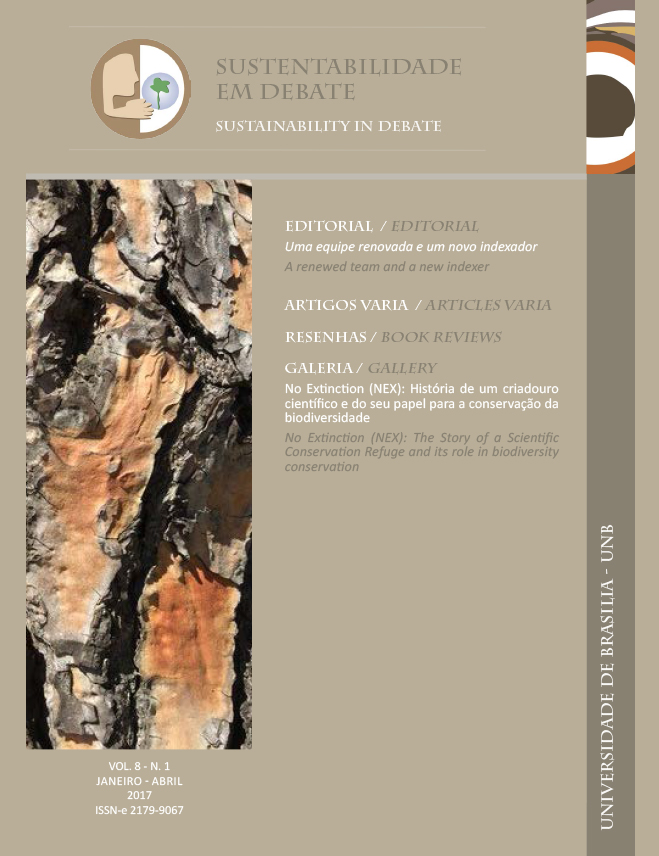No Extinction (NEX):
História de um criadouro científico e do seu papel para a conservação da biodiversidade
DOI:
https://doi.org/10.18472/SustDeb.v8n1.2017.25472Downloads
Referências
CASO, A.; OLIVEIRA, T. G; Carvajal, S.V. 2015. Herpailurus yagouaroundi. The IUCN Red List of Threatened Species 2015: e.T9948A50653167. http://dx.doi.org/10.2305/IUCN.UK.2015-2.RLTS.T9948A50653167.en. Acesso em: 22 de janeiro de 2017.
CAVALCANTI, S.; MARCHINI, S.; ZIMMERMANN, A.; GESE, E. M.; MACDONALD, D. W. Jaguars, livestock and people in Brazil: realities and perceptions behind the conflict .In: Macdonald, D.; Loveridge, A. (Eds). The biology and conservation of wild felids. Oxford University Press, Oxford, United Kingdom, p. 383-402, 2010.
DESBIEZ, A. et al. Plano de ação nacional para a conservação da onça-pintada /Orgs: Rogério Cunha de Paula, Arnaud Desdiez, Sandra Cavalcanti. ”“ Brasília: Instituto Chico Mendes de Conservação da Biodiversidade, ICMBio, 2013.
FRANCO, J. L. A. História da Panthera onca no Brasil: entre o terror e a admiração (séculos XVI-XXI). In: FRANCO, J. L. A.; SILVA, S. D.; DRUMMOND, J. A.; TAVARES, G. G. (Orgs.). História ambiental: territórios, fronteiras e biodiversidade, v. 2. Rio de Janeiro: Garamond, p. 393-426, 2016.
FRANKHAM, R. Efective population size/adult population size ratios in wildlife: a review. Genetical research, v. 66, p. 95-107, 2007.
HOUSER, A. Spoor density, movement and rehabilitation of cheetahs in Botswana. Pretoria: University of Pretoria, 2008. 132p . M.Sc. thesis. Centre for Wildlife Management, University of Pretoria, 2008.
HOUSER, A.; GUSSET, M.; BRAGG, C. J.; BOAST, L. K.; SOMERS, M. J. Pre-release hunting training and post-release monitoring are key components in the rehabilitation of orphaned large felids. South African Journal of Wildlife Research, v. 41, n. 1, p. 11-20, 2011.
IRIARTE, J. A.; JOHNSON, W. E.; FRANKLIN, W. L. Feeding ecology of the Patagonia puma in southernmost Chile. Revista Chilena de Historia Natural, v. 64, p. 145-156, 1991.
MARINI, M. A.; MARINHO FILHO, J. Translocação de aves e mamíferos: teoria e prática no Brasil. In: ROCHA, C. F. D.; BERGALHO, H. G.; SLUYS, M. V.; ALVES, M. A. S (orgs). Biologia da Conservação: Essências, p. 505-536, 2006.
MCPHEE, M. E.; CARLSTEAD, K. The importance of maintaining natural behaviors in captive mammals. In: KLEIMAN, D. G.; THOMPSON, K. V.; BAER, C. K. (Eds.). Wild mammals in captivity: principles and techniques for zoo management. 2nd edition. Chicago: University of Chicago Press. p. 303-313, 2010.
MORATO, R. G.; MELLO BEISIEGELl, B.; RAMALHO, E. E.; CAMPOS, C. B.; BOULHOSA, R. L. P. Avaliação do risco de extinção da onça-pintada Panthera onca (Linnaeus, 1758) no Brasil. Biodiversidade Brasileira, v.3. n. 1, p. 122-132, 2013.
MORATO, R. G. et al. Space Use and Movement of a Neotropical Top Predator: The Endangered Jaguar. PloS one, v. 11, n. 12, 2016. http://journals.plos.org/plosone/articleid=10.1371/journal.pone.0168176
OLIVEIRA, T. G.; CASSARO, K. Guia de campo dos felinos do Brasil. Instituto Pró-Carnívoros, 2005.
OLIVEIRA, T.G; ALMEIDA, L. B.; CAMPOS, C. B. Avaliação do risco de extinção da jaguatirica Leopardus pardalis (Linnaeus, 1758) no Brasil. Biodiversidade Brasileira, v. 3, n. 1, p. 66-75, 2013.
QUEIROLO, D.; ALMEIDA, L. B.; BEISIEGEL, B. M.; OLIVEIRA, T. G. Avaliação do risco de extinção do Gato-palheiro Leopardus colocolo (Molina, 1782) no Brasil. Biodiversidade Brasileira, n. 1, p. 91-98, 2013.
SILVEIRA, L. Ecologia Comparada e Conservação da onça-pintada (Panthera onca) e onça-parda (Puma concolor), no Cerrado e Pantanal. Brasília: UnB, 2004. 240p. Tese (Doutorado). Programa de Pós-Graduação em Biologia Animal, Universidade de Brasília, Brasília, 2004
WILSON, D. E.; REEDER, D. M (eds). Mammal species of the world: a taxonomic and geographic reference. JHU Press, 2005.
YOUNG, R. J. Environmental enrichment for captive animals. Blackwell Publishing, 2003.
Downloads
Publicado
Como Citar
Edição
Seção
Licença
A submissão de trabalho(s) científico(s) original(is) pelos autores, na qualidade de titulares do direito de autor do(s) texto(s) enviado(s) ao periódico, nos termos da Lei 9.610/98, implica na cessão de direitos autorais de publicação impressa e/ou digital à Revista Sustentabilidade em Debate do(s) artigo(s) aprovado(s) para fins da publicação, em um único número da Revista, autorizando-se, ainda, que o(s) trabalho(s) científico(s) aprovado(s) seja(m) divulgado(s) gratuitamente, sem qualquer tipo de ressarcimento a título de direitos autorais, por meio do site da Revista, para fins de leitura, impressão e/ou download do arquivo do texto, a partir da data de aceitação para fins de publicação. Portanto, os autores ao procederem a submissão do(s) artigo(s) Revista, e, por conseguinte, a cessão gratuita dos direitos autorais relacionados ao trabalho científico enviado, têm plena ciência de que não serão remunerados pela publicação do(s) artigo(s) no periódico.
A Revista encontra-se licenciada sob uma Licença Creative Commons Atribuição-NãoComercial-SemDerivações (Proibição de Realização de Obras Derivadas) 3.0 Brasil, para fins de difusão do conhecimento científico, conforme indicado no sítio da publicação, que permite o compartilhamento do texto e o reconhecimento de sua autoria e publicação original nesta revista.
Os autores têm permissão para assumir contratos adicionais separadamente, para distribuição não-exclusiva dos trabalhos publicados na Revista Sustentabilidade em Debate (por exemplo, em um capítulo de livro), desde que seja assinalado que os textos foram originalmente publicados nesta revista e que seja mencionado o DOI correspondente. Os autores têm permissão e são estimulados a publicar e distribuir o seu texto online, após a publicação (por exemplo, em repositórios institucionais ou nas suas páginas pessoais).
Os autores declaram expressamente concordar com os termos da presente Declaração de Direito Autoral, que se aplicará a submissão caso seja publicada por esta Revista.






